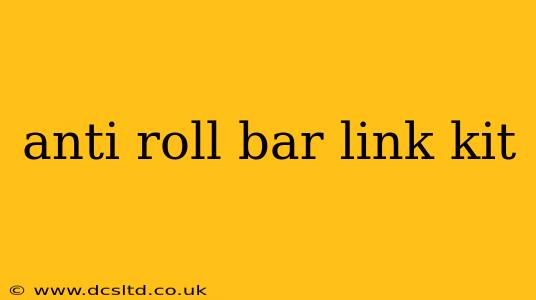An anti-roll bar link kit is a crucial component for enhancing your vehicle's handling and stability. This kit typically includes upgraded links, bushings, and sometimes even the anti-roll bar itself, designed to improve performance and reduce body roll. Understanding the intricacies of these kits is vital for anyone looking to upgrade their vehicle's suspension. This comprehensive guide will explore everything you need to know about anti-roll bar link kits, answering common questions and providing valuable insights.
What is an Anti-Roll Bar Link Kit?
An anti-roll bar link kit is a collection of parts designed to replace or upgrade the existing links connecting your vehicle's anti-roll bar (also known as a sway bar) to the control arms or suspension. These links are vital in transferring the anti-roll bar's force, which helps control body roll during cornering and acceleration. A worn-out or damaged link can significantly compromise the effectiveness of the anti-roll bar, resulting in poor handling and reduced stability. An upgrade kit often includes higher-quality materials and designs for increased durability and improved performance.
What are the Benefits of Upgrading to an Anti-Roll Bar Link Kit?
Upgrading to a higher-quality anti-roll bar link kit offers several significant benefits:
-
Improved Handling: Stronger, more robust links provide more precise control over body roll, leading to a more responsive and predictable handling experience. This is especially noticeable during cornering and high-speed maneuvers.
-
Enhanced Stability: Reduced body roll translates to increased stability, particularly on uneven surfaces or during emergency maneuvers. This enhanced stability contributes to a safer and more confident driving experience.
-
Increased Durability: Upgrade kits often utilize materials like hardened steel or aluminum, providing superior resistance to wear and tear compared to stock components. This extends the lifespan of the suspension system.
-
Reduced Body Roll: The primary function of the anti-roll bar is to reduce body roll. Upgraded links ensure that the anti-roll bar functions optimally, minimizing body roll and maximizing handling precision.
What are the Signs That I Need a New Anti-Roll Bar Link Kit?
Several signs indicate that your vehicle's anti-roll bar link kit may require replacement or upgrading:
-
Excessive Body Roll: If you notice significantly increased body lean during turns or acceleration, it could signify worn-out or damaged links.
-
Clunking or Rattling Noises: Unusual noises emanating from the suspension area, especially during cornering or driving over bumps, can point to worn bushings or damaged links.
-
Loose or Wobbly Feeling: A loose or unstable feeling during driving, particularly when cornering, can also be a symptom of failing anti-roll bar links.
-
Visible Damage: Inspect the links for any signs of bending, cracking, or excessive wear. This is a clear indication of the need for replacement.
How Often Should I Replace My Anti-Roll Bar Links?
The lifespan of anti-roll bar links varies depending on factors such as driving style, road conditions, and vehicle usage. However, a general guideline is to inspect them every 25,000-50,000 miles or at least once a year. If you frequently drive on rough roads or engage in aggressive driving, more frequent inspections are recommended.
What Types of Anti-Roll Bar Link Kits Are Available?
Various anti-roll bar link kits are available, differing primarily in materials, construction, and adjustability:
-
Stock Replacement Kits: These kits offer direct replacements for worn-out factory links, providing improved durability at a reasonable price.
-
Performance Upgrade Kits: These kits often utilize higher-strength materials and more sophisticated designs, offering significant improvements in handling and stability.
-
Adjustable Kits: Adjustable kits allow for fine-tuning of the anti-roll bar's stiffness, enabling customization to suit individual driving preferences and vehicle setups.
Can I Install an Anti-Roll Bar Link Kit Myself?
While technically feasible for those with mechanical aptitude and the right tools, installing an anti-roll bar link kit can be challenging. It often involves working under the vehicle, dealing with suspension components, and requiring precise alignment. Incorrect installation can compromise handling and safety. Consider seeking professional installation from a qualified mechanic if you lack the necessary experience.
What are the different materials used in anti-roll bar link kits?
Common materials include steel, aluminum, and polyurethane. Steel offers high strength and durability, aluminum provides a lighter weight option, and polyurethane bushings improve the quietness and ride comfort.
This comprehensive guide provides a solid foundation for understanding anti-roll bar link kits. Remember, proper maintenance and timely upgrades are essential for ensuring optimal vehicle handling, stability, and safety. Consult your vehicle's manual or a qualified mechanic for specific recommendations.
